Πηγή:
How did the Iranian Revolution go so far off the rails? – People's World
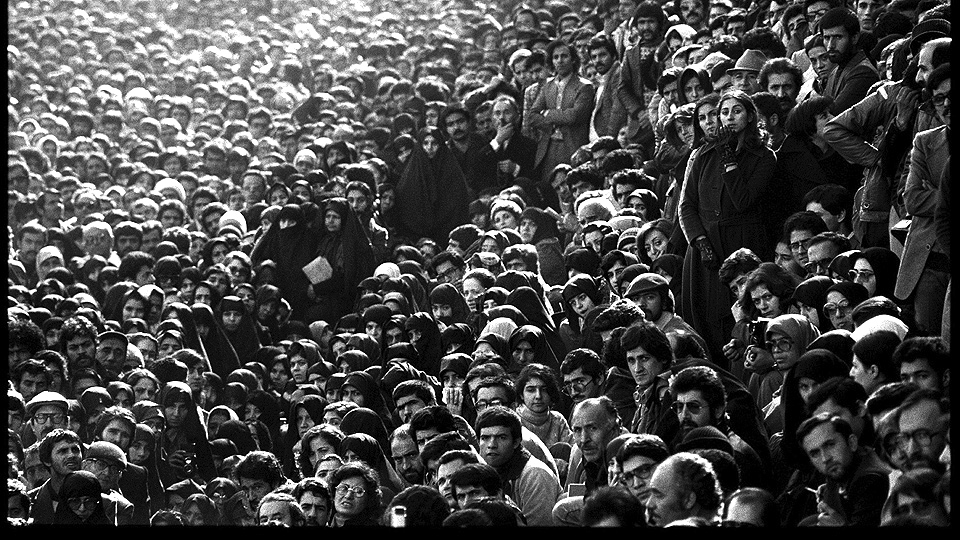
The Iranian Revolution was supported by millions of people from all walks of life. | Courtesy Tudeh Party of Iran
Even though it has to wage much of its struggle underground, the Tudeh Party of Iran, 40 years after the overthrow of the autocratic U.S.-installed Shah, continues the fight for a secular, democratic, and socialist Iran. The following is an exclusive interview with Mohammad Omidvar, a member of the political bureau of the Tudeh Party.
Since left and progressive forces, including labor unions, wage
an underground struggle in Iran, special measures had to be taken to
conduct this interview. The questions and the answers were transmitted
to and from Iran by a People’s World source outside that country. The
Tudeh Party chose People’s World as the venue for this important
interview because it wanted to give people in our country, on the 40th
anniversary of the Iranian Revolution, a better understanding of what is
happening in Iran.
The movement that started out with great hope for the future of
that country became, for many reasons, a failed revolution. This
interview helps clarify for our readers the reasons for this failure and
outlines the direction in which the progressive forces in Iran hope to
lead their country now. Omidvar also explains why the Tudeh Party
opposes current U.S. sanctions against Iran and why the Trump policy of
regime change is so fiercely opposed by the country’s progressive
forces.
– John Wojcik, editor-in-chief, People’s World
People’s World:
Progressive forces around the world had assessed the February 1979
revolution in Iran as a broadly-supported, all-encompassing social
revolution, one of the most exciting and popular uprisings of the 20th
century. What were the key factors in the final years of the Shah’s rule
that led to the revolution? Iran under the Shah was often represented
in the Western media as a strong, modern, and even democratic country.
Was this the case?
Mohammad Omidvar—The 1979 revolution in Iran was a national
democratic revolution, a classic example of a majority- supported
revolution that took place in the particular circumstances of the growth
of capitalism in Iran. In the 1960s and ’70s, Iranian society faced a
profound structural crisis due to the expansion of capitalist
relations whereby representatives of the comprador bourgeois class
dominated the political and economic life of the country.
The ever-increasing influence of capital in the Iranian economy, with
a police state that prevailed to safeguard the despotic client
regime, resulted in the middle strata becoming ever more squeezed. This
also led to the weakening of the economic positions of sections of the
national bourgeoisie. It is also noteworthy that during the same period
the working class was experiencing a modest growth due to the migration
of a large number of people from rural areas into cities as a result of
the pseudo-land reforms enacted. The real reason for these limited
reforms was to eliminate the threat to the Shah’s regime from large
landowners.
This gave the growing working class more social weight within the
class structure of our society. The 1979 Revolution, therefore, arose
from serious socio-economic crises and class contradictions
created by the dominating interests of comprador bourgeois and the
despotic rule of a corrupt, pro-western regime. It mobilized millions of
people—from workers, peasants, and the petty bourgeoisie to sections of
the small and medium national bourgeoisie—against the Shah’s regime.
The Iranian Revolution and the toppling of the Shah’s
regime was supported by the vast majority of people; millions were in
the streets calling for change. What were the key demands of the
majority of these forces in the 1979 Revolution, and was the
establishment of a theocratic state one of them?
As mentioned before, a wide range of social forces—from the working
class to the national bourgeoisie, the middle strata, and the petty
bourgeoisie, and the various socio-political forces representing their
interests—participated in the revolution with different perspectives and
programs. The people’s slogan was “Freedom, Independence, and Social
Justice,” and that was the approach supported by our party. The
religious forces insisted on adding the “Islamic Republic” to the
people’s demands; they did not reveal, at first, what that would mean in
practice. They revealed nothing of the characteristics of the kind of
state they were planning.
How and why did the forces of what you describe as
“political Islam” manage to gain the upper hand? Wasn’t it possible for
other revolutionary and/or secular forces to prevent this?
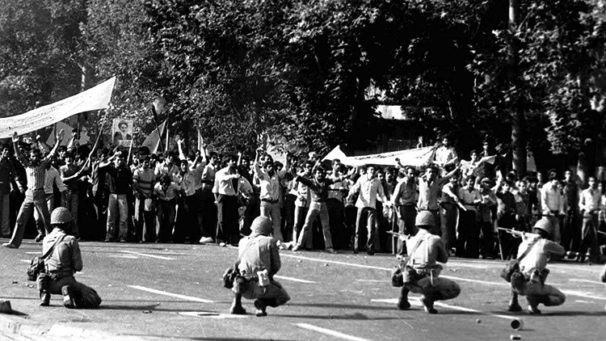
The ruling theocratic regime’s propaganda claims that the people of
Iran came to the streets to topple the regime of the Shah in order to
establish the “rule of Islam.” In reality, the 1979 Revolution had a
clear social and class context that was aimed at removing the
destructive influence of imperialist monopolies from our country,
securing Iran’s economic and political independence, establishing
justice, and democratizing the political and cultural life of our
society.
The 1979 Revolution ended up being taken over by religious forces for
a number of critical reasons, dating right back to the aftermath of the
1953 CIA-MI6 coup d’état in Iran, which re-established the Shah’s
regime. Over the following 25 years, while the left forces—especially
the Tudeh Party of Iran, the nationalist forces and, later on, the
guerrilla movements, including the People’s Fedaian and People’s
Mujahedin—were heavily suppressed by the security forces, the clergy
were allowed to use their networks, mosques, and religious events to
organize and promote their agenda (Political Islam).
The Shah’s regime and its dreaded security force, SAVAK, saw the
clergy as an important tool in countering the left and radical forces in
Iran. Indeed, in letters exchanged between then-President Carter and
Ayatollah Khomeini (now published in the mémoires of Dr. Yazdi,
Khomeini’s close confidante in Paris and Iran’s first post-revolutionary
foreign minister), the U.S. was prepared to tolerate Khomeini’s regime
provided they guaranteed to stop the influence of the Tudeh Party of
Iran in Iran’s post-revolution era.
In your publications, your assessment is that, after its
initial success in overthrowing the Shah’s regime and bringing about a
number of political changes, the 1979 Revolution was halted and
ultimately failed. What characterizes it as a failed revolution, and was
this inevitable? Could other revolutionary forces, including the Tudeh
Party, have done things differently, thereby altering the negative
course the revolution was taking? Did the left, including the Tudeh
Party, make any mistakes, in your estimation?
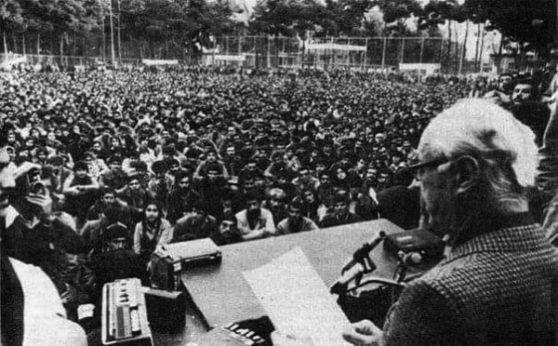
The Iranian Revolution successfully completed its political phase of
overthrowing the Shah’s despotic regime. It was clear to our party that
for the revolution to succeed, it needed to evolve into its social
phase, replacing the socio-economic order it had inherited from the
Shah’s regime with a new order.
Many of our party’s slogans and our platform—including the
nationalization of banks and multinational companies, as well as land
reform—was carried out in the atmosphere that existed in the first year
of the revolution. However, constant U.S. and reactionary interference
in Iran, including the imposition of the imperialist-instigated
Iraq-Iran War, stopped the revolution in its tracks and provided the
backdrop for Khomeini and his followers to stop these programs and move
towards the establishment of a theocratic regime.
At the time, conscious of challenges facing the revolution, our party
called for the formation of a “people’s united front” with other
revolutionary forces to make sure that the revolutionary movement would
not be derailed, but this did not materialize due to significant
political differences among those forces.
Our party, in its analysis of the early years of revolution,
concluded that in our policy of “critical unity” with Khomeini and his
followers, we were perhaps more concerned with unity than being critical
of some of the policies that clearly were not in line with
revolutionary ideals and the people’s demands. It is clear that had the
left-democratic forces managed to come together, it would have been
possible to change the balance of forces politically in the country for a
different outcome. The reactionary forces, in a matter of three years,
were able to attack the left and democratic forces one-by-one and then
establish their absolute rule in Iran.
The major slogans of the 1979 Revolution were for
freedom, independence, and the establishment of a republic, with
democratic rights and structures, to replace the Shah’s dictatorship.
What is the Tudeh Party’s assessment of the outcome of the revolution
for democracy, gender equality, the rights of ethnic and religious
minorities, and trade union rights in Iran?
Iran, 40 years after the revolution, is ruled by a despotic regime
with no regard for human and democratic rights. Over past decades, we
have witnessed laws restricting women’s rights and their treatment as
second-class citizens. This has included medieval laws permitting the
marriage of girls as young as 11, as well as enforcing gender
segregation in places of education and even hospitals.
The regime has also ruthlessly suppressed the basic rights of ethnic
and national minorities, as well as religious minorities. Its record on
trade union rights remains appalling. Many trade unionists are
imprisoned or exiled and trade union activity either restricted by the
state or forced underground. The regime has never accepted the legal
operation of trade unions. It only permits Islamic Labor
Councils—tripartite bodies involving the employers, government
representatives, and employees—thus breaching ILO Conventions 87 and 98,
guaranteeing all workers the right to belong to a trade union of their
choice and engage in trade union activities.
During the past forty years, many significant social
movements have demanded, and continue to demand, change in Iran. Have
these movements aimed to reform the political and socio-economic system
in Iran, or have they been directed towards a more fundamental change in
the social order?
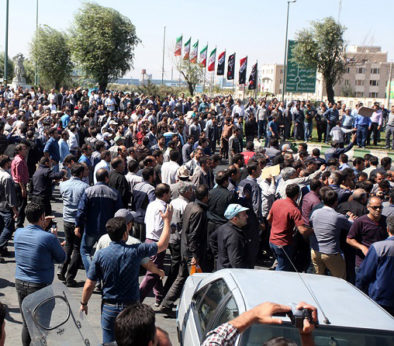
Over the past two decades, powerful social movements have emerged in
Iran demanding change in the way the country is ruled and rebelling
against corruption and repression. In 1997, Mohammad Khatami became
Iran’s president promising reform and the “rule of law.” There was a
powerful social force, from women to youth and students, behind Khatami,
and he received over 20 million votes in the election.
But his government’s promises were not realized due to their
overriding belief that change could only take place if permitted by the
“Supreme Religious Leader” and could not cross the “red lines” of the
Islamic Republic. Over the eight years of Khatami’s presidency, despite
some respite in terms of the oppression, real changes to Iran’s power
structure never materialized, and the regime was able to neutralize the
social movements and gain the initiative against them.
Socio-economic conditions continue to worsen in Iran. Poverty is at
unprecedented levels, with some estimating 40 percent of the population
being below the poverty line, all while the regime has sold over $800
billion worth of oil over the last three decades. Now we are witnessing a
radicalization of people’s demands amidst growing workers’ strikes and
protests. In late 2017 and into 2018, we had sporadic protests in 80
Iranian cities which the regime suppressed savagely. And over the past
three months, we have been witnessing prolonged workers’ strikes in key
industries such as steel, automobile, and sugarcane in the south of
Iran. People are demanding an end to the current neoliberal policies of
privatization, economic hardship, and the unprecedented levels of
corruption.
One of the characteristics of the 1979 Revolution was its
then-stated “anti-imperialist” position. Some of the acts of the
theocratic leadership were seen by some on the left as having a
progressive motivation, as Iran’s way of protecting its sovereignty. How
does the Tudeh Party assess the theocratic leadership’s stated policy
of being opposed to U.S. imperialism? Is it sincere? Has the foreign
policy of the Islamic Republic of Iran benefitted the Iranian people in
any way?
It is true that one of the key characteristics of our revolution was
its anti-imperialism, and especially in opposition to U.S. imperialism,
due to their long-term interference in our country and plundering of our
national resources, including oil and gas. The religious leaders used
these slogans, which were mainly viewed as Tudeh Party slogans, to
consolidate their position in the revolutionary movement
Clearly, their anti-American slogans were not based on the same
understanding as the anti-imperialist slogans of the left and our party,
which reflected our view of the destructive role of monopoly capital on
the world stage and our belief that anti-imperialist forces should
unite and work together to build a different world. The Iranian regime’s
ideal economic model was that of a capitalist order wrapped up with
empty Islamist slogans.
For the Iranian regime, its influence in the region and the building
of an Islamic empire was a critical part of its foreign policy and, as
such, clashed with that of reactionary and puppet regimes in Saudi
Arabia and other Arab states in the Persian Gulf region. It is also
important to note that at the most critical points in our region’s
recent history, including the imperialist aggression in Afghanistan and
Iraq, the Iranian regime—according to its own leaders—helped U.S. plans
by opening up the country’s airspace so that attacks could be carried
out against both neighboring countries.
The Trump administration is now openly following a policy
of regime change in Iran. What is your party’s position on the
possibility of such an external intervention? Can you give us your
opinion about the activities of President Trump, the Israeli government,
Saudi Arabia, and their allies?
In a statement by our Central Committee on May 1, 2018, in response
to the growing threat from the U.S. and its allies, our party opined
that: “In analyzing the current developments in the Trump administration
and the coordination—more than ever before—of the governments of Israel
and Saudi Arabia with that administration, many of the world news
agencies have commented that the risk of a military conflict between
Israel and Iran is now higher than ever.”
We further elaborated that: “Our country and the Persian Gulf region
and the Middle East is once again faced with a very serious and urgent
threat of catastrophic military conflicts which will have dire
consequences for Iran and the entire region. Ignoring these threats and
supporting the destructive and interfering policies of the U.S., Israel,
and Saudi Arabia, contrary to the claims of some of the foreign-allied,
anti-people, so-called opposition not only will not lead to the
liberation of Iran from the claws of the current theocratic regime but,
like the imperialist-inflicted war of Iraq with Iran (1980-88), will
have very damaging consequences for our nation, and for the popular
movement for freedom, sovereignty, and social justice. The struggle of
the Iranian people to dispose of the theocratic rule and establish a
national and democratic regime in Iran…is not achievable through the
destructive military intervention of such reactionary forces as the
Trump, Netanyahu, and Bin Salman administrations. In such critical
times, the most important task of all the national and democratic forces
is to organize and mobilize all peace-seeking forces of the nation and
the world to prevent another disastrous and destructive war in our
region.”
What is the attitude of the Tudeh Party and the
progressive and labor movement toward the sanctions imposed by the Trump
administration against Iran? How do the sanctions hurt progressive
forces?
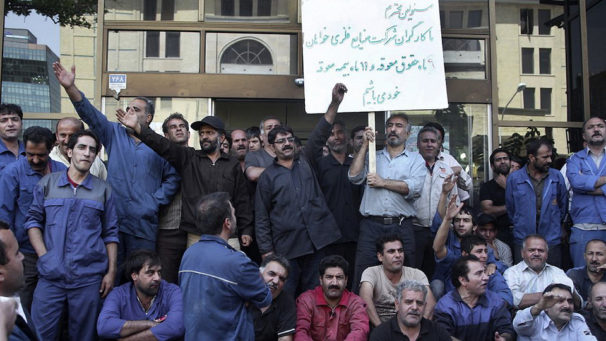
The Trump decision, in complete contravention of world public
opinion, to take the U.S. out of the 2015 Joint Comprehensive Plan of
Action (JCPOA) Agreement with Iran…has significantly increased tension
in the region and raised the threat of a new devastating war in the
Middle East.
We condemn the re-imposition of economic and banking/monetary
sanctions on Iran, which constitute an illegal violation of an
international agreement ratified by the UN Security Council and mostly
hurt the ordinary people of Iran. It is worth mentioning that similar
sanctions against Iraq, prior to the U.S.’ military attack on that
country in 2003, cost the lives of hundreds of thousands of vulnerable
citizens, including children and the elderly.
Despite Trump’s claim that his actions will help the Iranian people’s
struggle, it is clear that U.S. policy is to change the course of the
Iranian people’s struggle and facilitate a regime change to establish a
puppet government.
The struggle of the Iranian people against the religious dictatorship
in Iran can only be determined by the Iranian people and its
progressive forces. The backing of John Bolton and the Trump
administration for the Pahlavi family (the family of the deposed Shah of
Iran) and the so-called “National Council of Resistance” headed by
Maryam Rajavi—who for many years received the patronage and protection
of Iraqi dictator Saddam Hussein and who currently receives hundreds of
millions of dollars’ worth of support from the criminal Bin Salman
government regime in Saudi Arabia—clearly shows the real intentions of
the U.S. government towards Iran and our peoples’ struggle.
The Tudeh Party of Iran, along with other progressive forces in our
country, view U.S. sanctions and its interference in Iran as directly
opposed to the national interest of our country and our peoples’
struggle against the dictatorship in Iran.
What objectives is the Tudeh Party pursuing at this stage of the struggle for the transformation of your country?
Forty years after the victory of the 1979 Revolution, Iran is in need
of fundamental and democratic change. The future of our country should
be determined by our people, without external interference, through the
establishment of a democratic political system.
Iran has remained at the stage of National Democratic Revolution and
the Tudeh Party of Iran is committed to our country realizing the
following objectives: safeguarding national sovereignty; rolling back
and eliminating the neoliberal economic restructuring implemented by the
Islamic Republic; limiting and directing the growth of capitalism
towards the growth and development of the productive forces of our
national economy; the fair redistribution of materials and wealth; and,
the realization of democratic freedoms and social justice.
The Tudeh Party of Iran continues to believe that such a change
requires the formation of a united anti-dictatorship front by
mobilizing all social forces within our country and the emergence of a
strong union of left and progressive forces with effective participation
of the working class.
The Tudeh Party of Iran believes the most urgent goal of the
progressive forces in Iran is that they work together to prepare the
grounds for ending the absolute rule of the Supreme Religious Leader
once and for all, in order to open the way for fundamental democratic
and enduring change in our country.
Δεν υπάρχουν σχόλια:
Δημοσίευση σχολίου